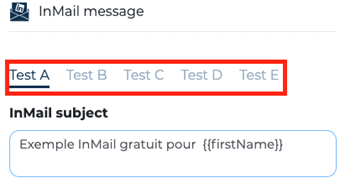New invitation limits on LinkedIn - The what, the how, and the trend of circumventing weekly restrictions
Today, we will cover everything you need to know about the new LinkedIn connection request limit – what it is, how it works, and what’s next (or how to avoid/circumvent it).After reviewing comments from many Q&A groups and lead generation sites, we decided to speak out about the weekly limit of 100 invitations to connect imposed by LinkedIn and the new trend of desperately finding a way to bypass it.You can automate your prospecting and generate up to 800 leads per month, by clicking here!
What You Need to Know
Any current LinkedIn user must come to terms with a few facts.First of all, as of now, a basic (free) LinkedIn account gets restricted or even banned for any high activity. By high activity, we mean something as minor as multiple profile views or searches.LinkedIn has made it impossible for a basic user to build a network or even generate leads—whether manually or using automation tools.So, unless you don’t actually need to be active on LinkedIn, just forget the free account…Next, if you want unlimited profile views, page visits, searches, and many other features that ensure quality targeting, you’ll need to upgrade to Premium or Sales Navigator (there’s a reason why these plans are so popular with sales teams 😉).Finally, LinkedIn has limited weekly invitations to about 100 per account.So don’t take it personally — in the second part of this article, you’ll learn how to bypass that 😉Everyone who properly prepared to sell on LinkedIn—optimized their profile, targeted the right prospects, and followed a smart strategy—has succeeded and will continue to generate leads, despite LinkedIn’s new restrictions.LinkedIn just wants to stop spammers and ensure high-quality networking. And honestly, so do you.The Mystery of the “Direct Invitation” Option
The “Direct Invitation” feature on LinkedIn was designed for connecting with people you know outside of LinkedIn. Therefore, it requires you to have their personal email addresses.In other words, instead of finding their profile and clicking “Connect,” you contact them via the online form below.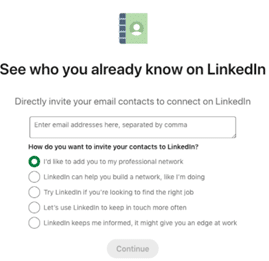

How (and Why) the “Direct Invitation” Option Is (Mis)Used
Whether you reach out to your prospects manually or with an automation tool, the only (ethical) way to collect personal emails is to first connect with them on LinkedIn — provided that info is public.If you’re already connected to someone on LinkedIn, the “Direct Invitation” isn’t needed: if their email is public, you’ll see it.The only case where this option makes sense is when you personally know the person and they’ve shared their email with you.Let’s say you’ve hit your weekly 100-invite limit, or for some reason your connection requests are pending. Some tools offer the following option:Using email finder and verifier tools, you can collect prospects’ emails without needing to connect on LinkedIn.Once you have them, you insert them in LinkedIn’s “Direct Invitation” and a message like the one above lands in your prospect’s work inbox or shows up as a notification on LinkedIn.Sounds okay, right? But…What’s Wrong with “Bypassing LinkedIn’s Weekly Invitation Limit”
If it’s not sent to the email connected to their LinkedIn account, your invitation is worthless.Let’s say you send a LinkedIn Direct Invitation to someone’s business email. But it’s not the one tied to their LinkedIn account.- They’ll receive an email with an image and message suggesting to connect.
- They must click “Join to see the invitation,” which leads to LinkedIn’s login page.
- Since it’s not the email used for login, they’ll need to enter the other email and password. Once logged in, there’s no pending invite.
Some Tools Use GDPR-Noncompliant Methods
Some lead generation platforms claim they can extract personal emails on LinkedIn even if the person is not a 1st-degree connection.How is that possible?These tools store data collected by users and build a database that is then shared with others.Giving other users access to data scraped from someone else’s account is 100% not GDPR-compliant. While enforcement is rare, it’s still a shady practice.Keep that in mind before adopting a “whatever it takes” mindset. Plus, this method is generally inefficient, as LinkedIn offers many ways for users to protect their data.LinkedIn Will Ban This Option Eventually
And yes, it’s already started with suspended accounts:

Leadin bypasses LinkedIn, but not its restrictions
When we use the expression “bypass LinkedIn“, we refer to Leadin’s multichannel approach, its smart sequences, and their ability to find alternate paths to your prospects.The smart sequences react to user behavior and choose the most direct way to reach out to them.Leadin’s ability to combine LinkedIn and email outreach, to discover and verify business emails, and to detect if a profile is open to free InMails, allows for multichannel contact with great efficiency.Each Leadin feature is a step in the smart sequence, not a separate action or something you need to do beforehand (it’s the #1 all-in-one tool!).Let’s see how “bypass LinkedIn” works with a simple example.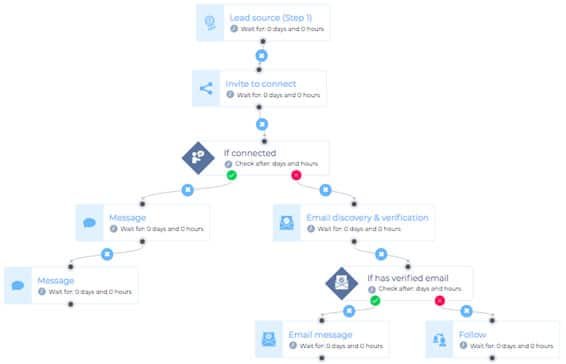

Time to level up your prospecting campaigns
Like most users, you can probably send only 100 invites per week, that is about 20–25 connection requests per day.Some people have reported getting this limit with or without LinkedIn Sales Navigator. However, having Sales Navigator and a warmed-up LinkedIn account helps, as we’ll see later.It’s hard to tell how this new invite algorithm works or what exactly triggers it.But we can assume LinkedIn wants more people to connect only with those they personally know.So even if you follow best LinkedIn outreach practices, LinkedIn can STILL limit your connection requests.Many are unsure what this means for the future of lead generation on LinkedIn, as connecting is usually step 1 of any prospecting campaign.To help you adapt to the new LinkedIn limit and get back to autopilot lead generation, here’s what we’ll cover today:- New LinkedIn limits: Re-optimize your account and campaigns for the invite cap
- Top 3 LinkedIn campaign strategies to increase acceptance rate
- How to bypass the new LinkedIn invite limit (what you should actually do)
New LinkedIn limits: Re-optimizing your account and campaigns for the weekly invite cap
When in doubt, restart from scratch.Here are a few common patterns from users whose accounts were affected by the new LinkedIn invite algorithm:- Connection acceptance rate was below 70% on average.
- The LinkedIn account wasn’t properly warmed or the profile wasn’t optimized for social selling. See how to boost your LinkedIn SSI based on the 4 pillars of social selling.
- Too many pending connection requests—you must withdraw those. We recommend keeping your pending requests under 700, and remove them if they go over.
- Or something else. Check these metrics to measure your campaign performance if something still feels off.
Getting the most from your LinkedIn profile
All LinkedIn outreach campaigns start with your profile.By now, you probably know it needs to be optimized for your target audience so prospects can instantly tell:- What you do.
- Why they should connect with you.
- How your offer or solution helps them.
- LinkedIn URL
- Background photo (banner)
- Profile picture
- Headline
- LinkedIn Summary
- Work experience
- Education
- Licenses and certifications
- Skills and endorsements
- Recommendations
- Interests
“Warming up” your LinkedIn account
Even if your LinkedIn account is old and previously warmed up, we recommend warming it again, just in case.Since we don’t know exactly what triggers LinkedIn’s new limit, it’s safer to be cautious. That includes re-warming your LinkedIn account.If you slowly increase the number of connection requests sent daily, LinkedIn might let you go past the 100 invites/week cap.But if you get more negative signals (low acceptance rate, few replies, etc.), LinkedIn may apply the limit faster.You’ll need to follow your gut and adapt your outreach campaigns accordingly. Luckily, A/B testing helps identify top-performing campaigns.Good news! With Leadin, LinkedIn warming is enabled by default and runs automatically for 15 days, gradually increasing your account’s activity:

Connection request limit – Activity restriction
Based on what we currently understand, here’s how LinkedIn’s new limit works:If LinkedIn detects suspicious activity from your account, it will monitor you more closely.So if your account is subject to a weekly limit and continues suspicious activity, LinkedIn is more likely to add further restrictions.Then, the number of invites you can send before another temporary ban becomes smaller and smaller.In other words: the more you spam, the longer the punishment.You should always limit your connection requests to the number of accepted requests, once you’ve hit LinkedIn’s activity suspension.For example, let’s say you send 20 connection requests and LinkedIn limits your outreach. When someone accepts your request, you can then send one additional connection request.If you’ve already reached the LinkedIn connection request limit, the number of requests you can send is equal to the number of people who’ve accepted your request since the temporary restriction.Always try to stay below the new limit LinkedIn has set for you.Once LinkedIn sees that you’re behaving correctly, you’ll be able to slowly increase the number of requests you send. Max out at around 20 connection requests, 5 days a week. We also recommend you pause outreach activity over the weekends.Of course, this should be done while closely monitoring your campaigns.LinkedIn Sales Navigator
While LinkedIn Sales Navigator won’t protect you from the new connection limits, it does help with better targeting, profile visits, and ultimately, a higher acceptance rate.Another thing to consider is your monthly people search usage.If you’ve used up your free searches with a basic account, LinkedIn will likely assume you’re using the platform to recruit or generate leads.Your search limit is based on your activity on LinkedIn.According to LinkedIn, activities that indicate recruiting or lead generation include:- Viewing a large number of profiles that aren’t 1st-degree connections.
- Searching for specific companies or employees of a specific company.
- Searching for 3rd-degree connections outside your network.
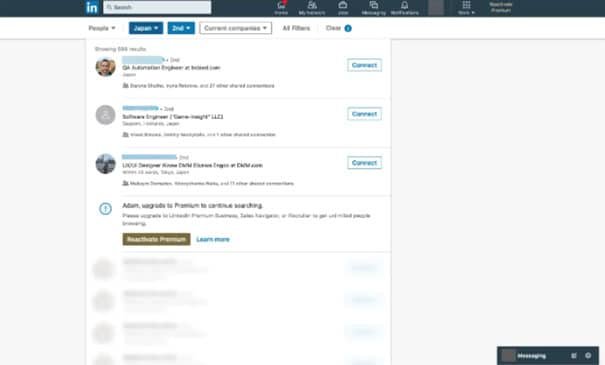

Top 3 LinkedIn Campaigns to Increase Your Connection Acceptance Rate
We’ve tried dozens of LinkedIn outreach and lead generation strategies.So, if you’re unsure where to start, try one of these three campaigns designed to boost your acceptance rate.Facebook Group Scraping Strategy
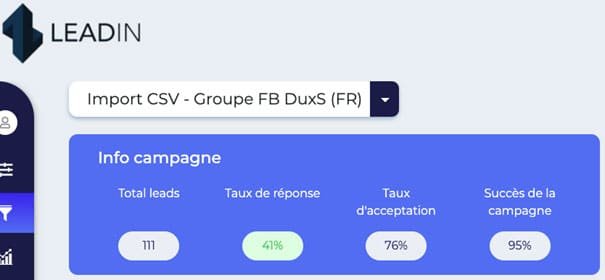

- Find a Facebook group where your target audience gathers (e.g. marketing groups, competitor user groups, etc.)
- Use Phantombuster’s Facebook Group Extractor to extract members.
- Use Phantombuster’s LinkedIn URL Finder to get the LinkedIn profiles of group members.
- Use Leadin to connect and engage with your prospects.
2. Content Retargeting Outreach Strategy
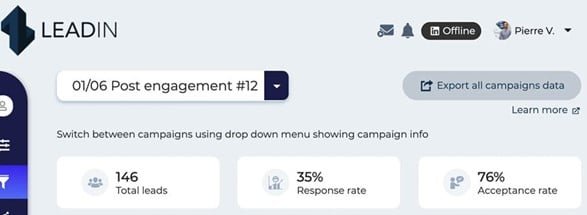

- Find a LinkedIn post with a high engagement rate.
- Copy the post URL from LinkedIn.
- Log in to Leadin. Create a new campaign, select “Post engagement,” and paste the copied link.
- Create your sequence and write your messages/emails to reach out to your prospect list by referencing the post or content category.
Hyper-personalization with dynamic images and GIFs to boost replies


- Identify leads matching your ICP using Sales Navigator.
- Create a campaign by importing those leads (copy/paste the Sales Navigator search URL) into Leadin and build your sequence with messages and emails.
- Click “Add Image” in your messages and/or emails, and upload an image or GIF. Pro tip: You can turn an iPhone photo into a GIF with the Lively app. Customize your image/GIF directly in Leadin by adding your prospect’s first name, LinkedIn photo, or company logo.
- Launch your campaign — that’s it! Your dynamic images/GIFs will now appear in messages, InMails, and emails.
Avoiding the New LinkedIn Connection Limit (What You Should Do)
Until now, the campaigns above focused on increasing your connection and response rates.But that’s not the only way to bypass LinkedIn’s new limits.Next, we’ll take a big-picture approach to lead generation and show you other prospecting campaigns that completely avoid the new connection limit.

- I reached out to 1,370 prospects with this campaign using free LinkedIn InMails and emails to their business addresses.
- 76% accepted my connection request or InMail, and 35% replied.
- Over 70 demos were booked from this campaign alone (so far!).


- Extract the audience of a LinkedIn event where your target audience is attending.
- Create a campaign in Leadin and add prospects using the “LinkedIn Search” option and the event’s LinkedIn URL.
- Create your sequence and add an “IF Free InMail” step to filter for open accounts, then add and write one or more InMails.
- Finish the sequence and start sending LinkedIn InMails — bypassing the 100 connection request limit.
